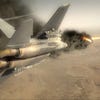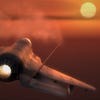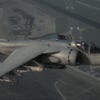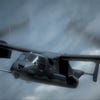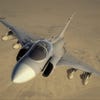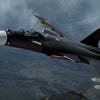Tom Clancy's H.A.W.X. 2
Bird of a feather?
So we intercept the lumbering cargo planes, around 20 of them in a well-spaced pattern over some prettily snow-covered mountains. It's all quite serene, a bit like a documentary about snow geese. The convoy asked to turn back. We're ignored. We fly closer to inspect, buzzing the bigger aircraft as a final warning.
Fighters swoop up from cloud cover below, ripping into our formation's unprotected undercarriages. Ambush.
Weapons are free and the sky is littered with the yellow diamonds indicating hostile targets. The big fat cargo swans are easy targets, for guns or missiles, but concentrating on them too much means I'll get chewed up by the fighters. Picking those out among the other targets is tricky at first, but they soon start to stand out, flitting between the larger vehicles in swooping loops like wasps around a sticky child.
Engaging them amidst the cargo planes is initially confusing, but we're high enough to not risk crashing, so acrobatic dogfighting is the order of business. Switching targets with Y, I pick a Flanker to hunt, holding the button down to keep the camera focused on my current target as I manoeuvre.
The yellow square over the SU-27 is chased by the red diamond of my missile lock, eventually clicking in when I've kept my foe front and centre for a few seconds. If I get too close, my heat-seekers won't have room to find their target and will fail to lock. Even if they do, there's a chance that the enemy will dodge the impact with a sharp turn or by dropping some flares.
These are tools in my arsenal, too - and it's not long before I have to use them. When an enemy gets a lock on your aircraft, you'll get a warning, followed by another when a missile is launched. A final chance to escape comes from a screen-in-screen view of the approaching missile as it gets closer - but last minute evasive heroics are nowhere near as reliable as the option of flares.
At bingo fuel following the engagement, I request landing at base. Negative, comes the reply - base under attack. It's time for a mid-air refuelling session - a phenomenon which my girlfriend refused to acknowledge existed until I showed her a video on Youtube. It's tricky, fittingly but not frustratingly so. An assist mode guides me into the correct position behind the refuelling plane, before some precision manoeuvring guides the fuel line home.
The last mission is called Oil City, an assault on a collection of heavily defended rigs which I can't help but feel is some sort of warning to BP to pull its socks up. It starts with a short runway carrier take off, catapulting to flight-speed in two or three seconds. The mission itself involves reducing the facility's defences in time for a marine assault force to embark and take it over, but it offers me my first opportunity to try out a landing at the newly recovered airstrip when I run out of shooty-things to point at the insurgents.
Capturing points like this in order to provide a place to refuel and restock weaponry will add a strategic element to play, Douglas says, although it also serves as an excellent reminder to me that putting a fighter down safely is a lot easier if you remember to lower your landing gear. Second time round, I pull it off, just in time for us to be loaded back into the Clancy-branded Land Rover and ferried back to Hammersmith.
As we drive back, the 'soldier' in front finally removes his helmet, after enduring it bravely for 6 hours in the muggy heat of a July afternoon. "Oooh, that's better," he says in a fairly broad Northern accent. Somehow I don't think Tom Clancy would approve.

